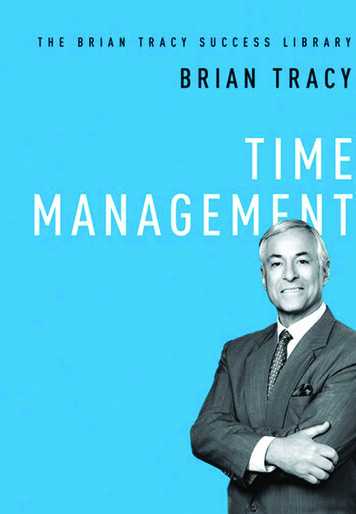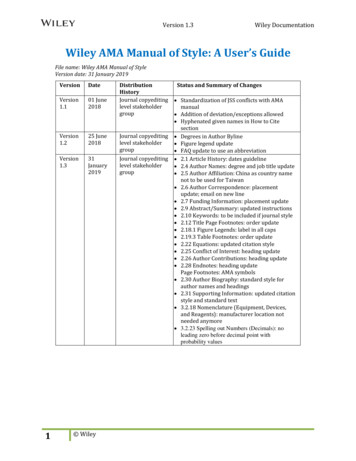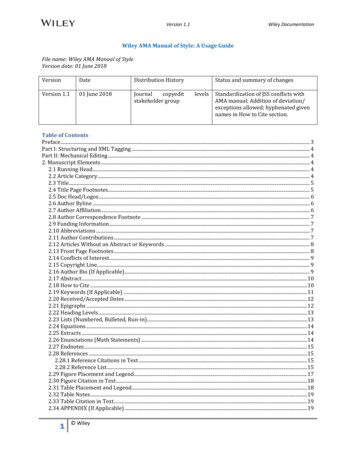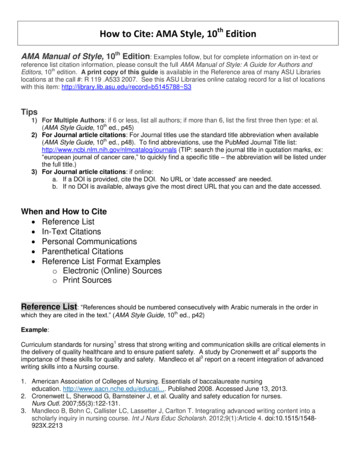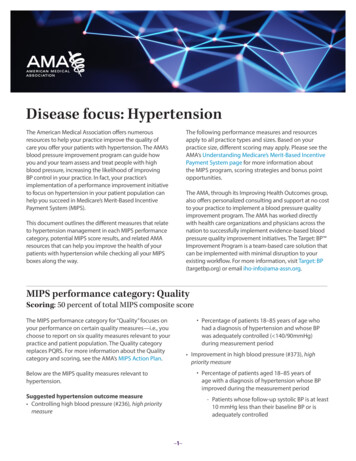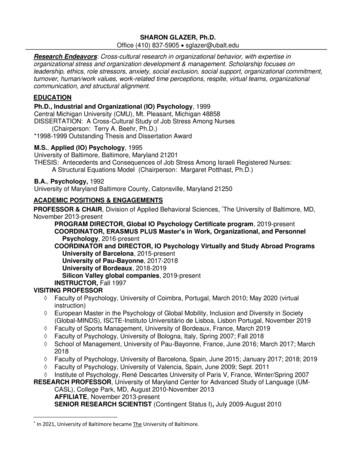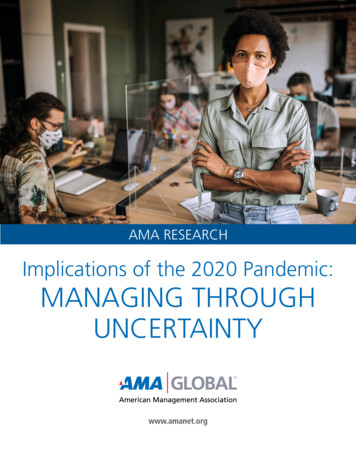
Transcription
AMA RESEARCHImplications of the 2020 Pandemic:MANAGING THROUGHUNCERTAINTYwww.amanet.org
IntroductionWhat was the most-used phrase of 2020? Perhaps it was “You’re on Mute” or “Can you see my screen?” Another likelycandidate is the acronym VUCA (Volatile, Uncertain, Complex, Ambiguous), as in “this is a VUCA world we live in today.”This acronym developed in military intelligence circles several decades ago, but 2020 was likely the year of its widest usage,because it so accurately describes life and work during a pandemic. Of these four characteristics (volatility, uncertainty,complexity and ambiguity), uncertainty may be the most challenging to experience. Whereas ambiguity is a difference ofinterpretation regarding information, uncertainty means not knowing, not being able to get all of the relevant facts, nothaving the information.COVID has generated uncertainty in so many facets of our lives. Specialists are still researching exactly how it spreads andhow long immunity can last. Guidelines regarding how to safeguard your health are constantly changing. Consequently,the pandemic has generated organizational uncertainty. There were doubts as to whether or not we would be able tosuccessfully work remotely. For how long? What would happen to teamwork and motivation? When will we return to colocated working? Will our work environment be different?Research in psychology and anthropology suggests that most of us are very uncomfortable with uncertainty. Given that2020 was a year of pronounced and prolonged uncertainty, many observers assumed that organizations and employeeswould perform poorly in this pandemic. American Management Association (AMA) conducted a survey whose resultsdisprove such predictions. While almost every organization has been disrupted by the pandemic, many employees report anincreased capacity to manage and direct themselves; an increased ability to think creatively and innovate; and a sustainedsense of connection to their organization and its mission.In this study, participants were asked to assess their own performance during the pandemic, as well as their organization’soverall performance. Participants were AMA Members and other AMA customers who were geographically distributedthroughout the United States.2
KEY FINDING 1:Employees Have Become More Self-Directed and Self-ManagingParticipants responded to items designed to understand their capability to function autonomously while working remotely.Their responses suggest that employees have quickly and effectively adapted to the need to take more initiative:61%of participants indicated that, since the beginning of the pandemic,they have taken on additional roles and/or responsibilities.74%agreed that they have become more flexible and more agileregarding their work.61%agreed that working remotely has enabled them to be moreproductive because they can better manage time and workflow.61%agreed that working remotely has been a valuable opportunity tobecome more self-directed.58%agreed that working remotely has provided valuable opportunitiesto take more initiative.3
KEY FINDING 2:Employees Are More Creative and InnovativeParticipants responded to items designed to understand the effect of the pandemic and working remotely on theirability to think creatively and innovate.63%agreed that working during the pandemic has inspired them to take more initiative and find innovative solutionsto solving problems.65%agreed that they and their colleagues have becomemore nimble and more agile.67%agreed that they and their colleagues have becomemore innovative.4
KEY FINDING 3:Employees Feel Connected to Teams and Organizational MissionSurvey participants responded to items designed to understand the effect of the pandemic and remote workingon intrinsic motivators, such as their feelings of commitment to their organization’s mission and their abilityto work effectively in teams:37%i ndicated that remote work did not negatively affect theirability to feel connected to colleagues and teams (23.3% ofrespondents were neutral).32%27%36%35% indicatedthat lacking face-to-face interactions withcolleagues did not negatively affect their awareness of workacross the organization (21.9% of respondents were neutral). indicatedthat working remotely did not negatively impacttheir sense of connection to their organization and itsmission (28.0% of respondents were neutral). indicatedthat working remotely has led to more frequentinteractions among managers, direct reports and teams(33.4% of respondents were neutral). indicatedthat working remotely did not reinforce“silos” and other divisions within their organization(37.3% of respondents were neutral).5
Implications of FindingsGiven social scientific data suggesting that people have an aversion to uncertainty, these survey results may be surprising.For example, remote work has not had the overwhelmingly negative impact on team cohesion that many had expectedin the early months of the pandemic. Rather, team work may not have been impacted at all; and, in some instances,communication among managers, individual contributors, and teams has become more deliberate and has thus improved.Likewise, in recent years, accepted wisdom has asserted that random, spontaneous in-person encounters and impromptuwater-cooler conversations are the life-blood of creativity and innovation. Yet, participants in this survey report increasedcreativity and innovation, although their interactions with colleagues now must be deliberately conducted in writing (emailsand texts) or scheduled (phone calls and virtual meetings).In a similar way, early-pandemic concerns about individuals’ ability to manage their time and achieve results, withoutthe direct supervision common to co-located work, are not supported by these results. Such concerns may have reflectedan assumption that most employees are motivated by what some researchers label a “control orientation” (meaningemployees are motivated by externally reinforced standards). Participant responses suggest that they have developed agreater autonomy orientation during the pandemic (meaning they are motivated by an internal satisfaction with a sense ofself-efficacy and achieving results). It appears that employees feel more empowered to be self-directed, even in the face ofthe uncertainty generated by the pandemic and related economic challenges.6
ConclusionHere are the top 5 must-have skills professionals need during timesof change and uncertainty: Having a positive approach to managing change Managing a hybrid or remote team A pproaching new challenges with agilityand innovation D emonstrating strong projectmanagement skills Building strong relationships2021 has begun with continued uncertainty. For instance, researchers are still learning how the COVID virus mutates. Thereis also uncertainty about people’s behavior. Even when individuals can be effectively vaccinated against COVID, will theyfully return to the consumer choices they were making before the pandemic? Or, will they continue to forego some types ofactivities and will some industries, such as those associated with entertainment, be permanently changed?Questions about behavior change also involve the way individuals work. As these survey results suggest, employees arebecoming more self-directed, more autonomous; they are becoming more agile; they are figuring out how to collaboratecreatively without the familiar tools and patterns of co-located work. The behavior changes raise the question: After anextended period of self-management and self-direction, what will employees need to stay engaged once they return to theoffice? What will organizations need to change regarding management styles and supervision? How will organizations shiftto a greater focus on results? The behavior changes suggested by this study are largely positive. Organizations need to beready to leverage these new strengths in the weeks and months to come.Anticipating organizations’ need to leverage positive changes in employee ability and behavior, AMA asked survey participantsto identify the capabilities that are most critical to succeeding in this new work environment.AMA is committed to providing opportunities for individuals at all levels of the organization to capitalize on the strengths theyhave developed during the pandemic, and to develop the capabilities and skills essential to thriving in these VUCA times. Asorganizations re-define the approach they take to developing their talent, they can trust AMA to provide them with optionsthat drive behavior change and have a positive lasting impact.Prepared by Haywood Spangler, PhD, AMA Trainer and Faculty Memberwww.amanet.org7
Research in psychology and anthropology suggests that most of us are very uncomfortable with uncertainty. Given that 2020 was a year of pronounced and prolonged uncertainty, many observers assumed that organizations and employees would perform poorly in this pandemic. American Management Association (AMA) conducted a survey whose results
